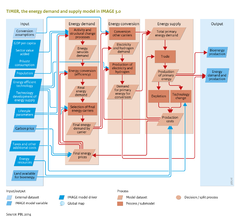Energy supply and demand: Difference between revisions
Jump to navigation
Jump to search
No edit summary |
No edit summary |
||
| Line 5: | Line 5: | ||
|ExternalModel=POLES model | |ExternalModel=POLES model | ||
|KeyReference=Van Vuuren, 2007; De Vries et al., 2001 | |KeyReference=Van Vuuren, 2007; De Vries et al., 2001 | ||
|Reference=Criqui | |Reference=De Vries et al., 2001; Van Vuuren, 2007; Criqui et al., 2003; Thomson et al. 2011; | ||
|Description=Energy | |Description=Energy consumption and production constitutes a central component in discussions on sustainable development. First of all, without the use of energy most human activities are impossible. Hence, securing a reliable and affordable supply of fit-for-purpose energy is an important element of countries' economic and energy policies. Fossil-fuel resources currently account for more than three quarters of the world's energy use. However, over time, depletion is expected to lead to rising costs for fossil fuels (at least for oil), while the fossil fuels resources that remain easily accessible will be concentrated in a decreasing number of countries. Finally, the combustion of fossil fuels and traditional forms of bio-energy is the single most important cause of local and regional air pollution and greenhouse gas emissions. The future of the global energy system is highly uncertain and depends on factors such as technological innovations and breakthroughs, socio-economic developments, resource availability and societal choices. Exploring different scenarios for developments around the use and supply of energy in the future provides information to decision-makers, on which strategic policy decisions can be based. | ||
==The energy supply and demand model (TIMER)== | ==The energy supply and demand model (TIMER)== | ||
The IMage Energy Regional model ( | The IMage Energy Regional model (also referred to as (TIMER model|TIMER)) is an energy model that has been developed to explore different scenarios for the energy system in the broader context of the IMAGE global environmental assessment framework ([[De Vries et al., 2001]]; [[Van Vuuren, 2007]]). TIMER is an energy system simulation model, describing the demand and supply of 12 different primary energy carriers in 26 world regions. Its main objective is to analyse the long-term trends in energy demand and supply, in the context of the sustainable development challenges described in the first paragraph . For this purpose, the model simulates long-term trends in energy use, issues related to depletion, energy-related greenhouse gas and other air polluting emissions, along with land-use demand for energy crops. The focus is on dynamic relationships within the energy system, such as inertia and learning-by-doing in capital stocks, depletion of the resource base and trade among the different regions. Similar most other parts of IMAGE, TIMER also is a simulation model. Its results depend on a single set of deterministic algorithms according to which the system state in any future year is derived entirely from previous system states. This differs from most macroeconomic models, which let the system evolve on the basis of a minimisation (of cost) or a maximisation (of utility) under boundary conditions. As such, TIMER can be compared to energy simulation models such as POLES ([[Criqui et al. 2003]]) and GCAM ([[Thomson et al. 2011]]). First, the energy supply and demand model is briefly introduced, followed by discussions on the different parts of the model in more detail, in subsequent sections. | ||
=== | |||
==Model description== | |||
The energy supply and demand model ([[TIMER model|TIMER]]) has three components: 1) [[Energy demand]], 2) [[Energy conversion]], and 3) [[Energy supply]] (see figure on the right). Energy demand is determined for five main economic sectors (industry, transport, residential, services and other). For some energy carriers, such as electricity and hydrogen, energy conversion models describe how these carriers are produced. A final set of models describes the production of primary energy carriers. The model calculates prices endogenously for both primary and secondary energy carriers that drive investment in the technologies associated with these carriers. The description of the different energy flows allows for calculating greenhouse gas and air pollutant emissions. The three model components are presented in more detail in the next sections. | |||
ifferent parts of the model in more detail. | |||
|AggregatedComponent=Energy supply and demand | |AggregatedComponent=Energy supply and demand | ||
|FrameworkElementType=pressure component | |FrameworkElementType=pressure component | ||
}} | }} | ||
[[Page has default form::AggregatedComponentForm| ]] | [[Page has default form::AggregatedComponentForm| ]] | ||
Revision as of 16:45, 12 December 2013
|
Composition of Energy supply and demand Additional info |
| Component is implemented in: |
|
| Projects/Applications |
| Models/Databases |
| Key publications |
| References |
Description of Energy supply and demand
